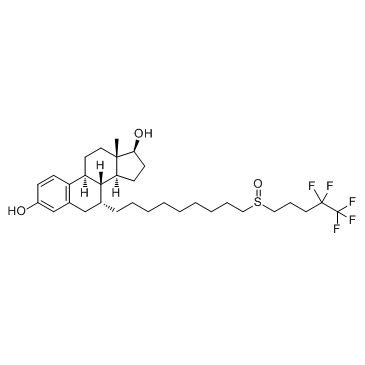Fulvestrant induces resistance by modulating GPER and CDK6 expression: implication of methyltransferases, deacetylases and the hSWI/SNF chromatin remodelling complex.
B Giessrigl, W M Schmidt, M Kalipciyan, M Jeitler, M Bilban, M Gollinger, S Krieger, W Jäger, R M Mader, G Krupitza
Index: Br. J. Cancer 109(10) , 2751-62, (2013)
Full Text: HTML
Abstract
Breast cancer is the leading cause of cancer death in women living in the western hemisphere. Despite major advances in first-line endocrine therapy of advanced oestrogen receptor (ER)-positive breast cancer, the frequent recurrence of resistant cancer cells represents a serious obstacle to successful treatment. Understanding the mechanisms leading to acquired resistance, therefore, could pave the way to the development of second-line therapeutics. To this end, we generated an ER-positive breast cancer cell line (MCF-7) with resistance to the therapeutic anti-oestrogen fulvestrant (FUL) and studied the molecular changes involved in resistance.Naive MCF-7 cells were treated with increasing FUL concentrations and the gene expression profile of the resulting FUL-resistant strain (FR.MCF-7) was compared with that of naive cells using GeneChip arrays. After validation by real-time PCR and/or western blotting, selected resistance-associated genes were functionally studied by siRNA-mediated silencing or pharmacological inhibition. Furthermore, general mechanisms causing aberrant gene expression were investigated.Fulvestrant resistance was associated with repression of GPER and the overexpression of CDK6, whereas ERBB2, ABCG2, ER and ER-related genes (GREB1, RERG) or genes expressed in resistant breast cancer (BCAR1, BCAR3) did not contribute to resistance. Aberrant GPER and CDK6 expression was most likely caused by modification of DNA methylation and histone acetylation, respectively. Therefore, part of the resistance mechanism was loss of RB1 control. The hSWI/SNF (human SWItch/Sucrose NonFermentable) chromatin remodelling complex, which is tightly linked to nucleosome acetylation and repositioning, was also affected, because as a stress response to FUL treatment-naive cells altered the expression of five subunits within a few hours (BRG1, BAF250A, BAF170, BAF155, BAF47). The aberrant constitutive expression of BAF250A, BAF170 and BAF155 and a deviant stress response of BRG1, BAF170 and BAF47 in FR.MCF-7 cells to FUL treatment accompanied acquired FUL resistance. The regular and aberrant expression profiles of BAF155 correlated directly with that of CDK6 in naive and in FR.MCF-7 cells corroborating the finding that CDK6 overexpression was due to nucleosome alterations.The study revealed that FUL resistance is associated with the dysregulation of GPER and CDK6. A mechanism leading to aberrant gene expression was most likely unscheduled chromatin remodelling by hSWI/SNF. Hence, three targets should be conceptually addressed in a second-line adjuvant therapy: the catalytic centre of SWI/SNF (BRG1) to delay the development of FUL resistance, GPER to increase sensitivity to FUL and the reconstitution of the RB1 pathway to overcome resistance.
Related Compounds
| Structure | Name/CAS No. | Molecular Formula | Articles |
|---|---|---|---|
 |
Palbociclib isethionate
CAS:827022-33-3 |
C26H35N7O6S | |
 |
Fulvestrant
CAS:129453-61-8 |
C32H47F5O3S |
|
CDK4/6 Inhibitor PD 0332991 Sensitizes Acute Myeloid Leukemi...
2015-05-01 [Cancer Res. 75 , 1838-45, (2015)] |
|
The Evolutionarily Conserved C-terminal Domains in the Mamma...
2015-06-05 [J. Biol. Chem. 290 , 14462-75, (2015)] |
|
CDK4/6 inhibitors have potent activity in combination with p...
2014-08-15 [Oncotarget 5(15) , 6512-25, (2014)] |
|
Feedback regulation between atypical E2Fs and APC/CCdh1 coor...
2016-03-01 [EMBO Rep. 17 , 414-27, (2016)] |
|
Control of regional decidualization in implantation: Role of...
2015-01-01 [Sci. Rep. 5 , 13863, (2015)] |